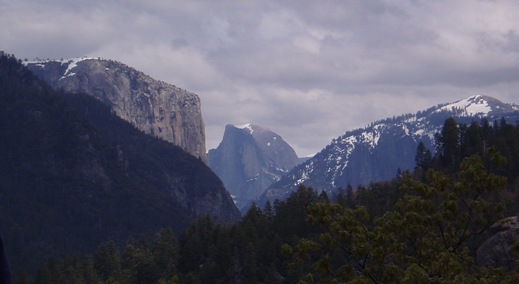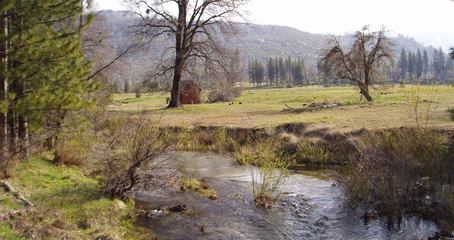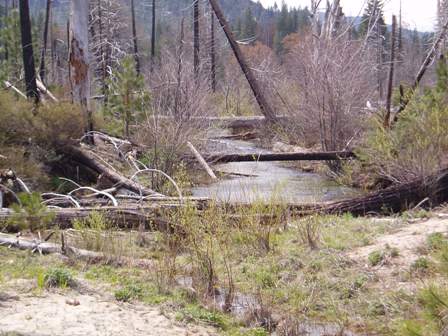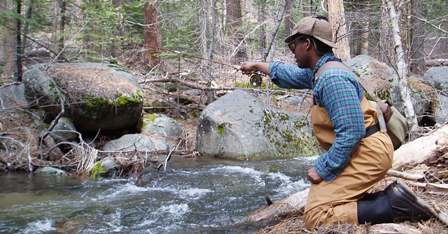|
|
|
|
|
April 30, 2005 Dead Fall Creek Time: 9:30am - 12:30pm Narrative:
Wildflowers and fast water. That’s early season fishing in Yosemite. Note that I didn’t say HIGH water. While some streams are too high for fishing, others are at a good level. Yosemite is a place were one can fish dry flies throughout the season and that’s what we did. Armed with two new, identically tapered bamboo rods, Gino and I hit a place I’ll call Dead Fall Creek. There are a few places in Yosemite that I’ll freely talk about. The South Fork Tuolumne, the Lyell and Dana Forks of the Tuolumne, the Merced, Yosemite and Tenaya Creeks, all are fairly well know or obvious fishing destinations. The Dana Fork in particular has become VERY popular over the past few years and this is in part why I maintain my silence on other park streams. In addition, many people of late have been "outing" Yosemite streams. I believe that small streams can become too well known and too popular. I think the Dana Fork is such a place. The streams we fished on this trip can be easily found with a map or a copy of Steve Beck’s Yosemite Trout guide, both are widely available. I've also made no attempt to hide the location and frequent park users will no doubt recognize Dead Fall Creek from the name I’ve given it as well as the pictures taken. Credit for catching fish this trip goes entirely to Gino. I guess the “student has become the master” or “the teacher also learns from the student” or some such over used cliché comes to mind. Frankly put, I would not have caught fish today if not for Gino. He figured out the pattern- absolute dead drifts were needed in deepish, soft water, right on the trout’s nose. The fish weren’t going to rise unless they were absolutely sure of your offering. A pink fly didn’t hurt either. Gino was catching fish on a pink parachute fly he picked up at the local fly shop. It was “Hendrickson Pink” in color but last I looked, Yosemite didn’t have any Hendricksons. Regardless, he was dapping the fly and picking up fish and I wasn’t. I was fishing fast, looking for active fish, figuring the other fish would be a sleep. I switched from nymphs to dry flies and back as I quickly moved up stream. I wasn’t feeling particularly confident as I moved up stream but being cold and in the early season, I really didn’t expect much. I caught up to Gino rather quickly given the terrain. The creek itself was rather typical for a stream flowing through flattish meadow. It was slightly brushy but the thing that would slow an angler down is not the brush but the trees. "What’s the difference", you’re probably thinking? Well, when you think of brush you generally think of trees and shrubs growing in and around the creek. They are part of the life of the creek. In the case of the trees I’m referring to, they were certainly part of the creeks near death.
To my surprise Gino not only had seen fish, but was catching them. I hadn’t even seen a fish, not even sent one running for cover and here he was actually catching them. I had to know the secret. “Pink Fly”, he said. ‘Scuse me? A what? A Pink Parachute fly he’d picked up at Fly Fishing Outfitters. He’d been in the fly shop and noticed the nearly empty bin and picked some up. Quite astute actually, the fly shop figured folks are buying them, so they must work and work they did. I quickly scanned my box. I’m pretty sure that the dapping was the key; but, why take chances. I scanned my box and came out with a fascia orange Sierra Bright Dot. I also decide to put on a new leader. I had picked up a Frog Hair supple butt leader from I don’t know where. It had been in my gear room for I don’t know how long and I decided to put it in my bag for this trip instead of buying a new leader. This is one great leader. Very, very supple but while fishing it, I couldn’t help think that a stiffer butt section would allow the leader to turn over better. Low and behold, when I later checked their web site, it turns out that they DO sell a leader with a stiff butt and supply tip. Needless to say, I’ve ordered some from Cabelas. I’d moved up above Gino and as he hop scotched his way above me, from a vantage point of 5 or so feet above the stream, he assured me that the hole I was fishing had fish. If he hadn’t said that, I probably wouldn’t have caught that first fish. The hole was a good one. 5 feet wide, with a small island in the middle, it went from about a foot deep to probably 30 inches deep. The island had soft pockets beside and immediately below it. I drifted my fly through several times, each time making sure to pick the fly up before it started to drag. I drifted fly through many more times past the point where I would have normally moved on. I wasn’t too sure about the rest of the stream, but I knew this run had fish. Gino told me so. On about the twentieth drift through the same whole, just as I was going to pick the fly up and move on, a fish slowly rose and accepted my fly. The rise was agonizingly slow, so slow that I remember telling myself to wait until the fish turns down with the fly, before setting the hook. I was literally able to think to myself, “Boy, that’s a slow rise. You don’t want to miss this fish. Wait until the fish turns down before setting the hook.” It takes me roughly 5 seconds to think that thought. THAT’s a slow rise.
We’d by passed this section of stream earlier, preferring instead to start our fishing further away from the parking area. This particular hole was too good to pass up. I made my first cast from the bank. It was a poor cast and drag set in immediate. After a few more poorly laid casts I hopped down the bank to the stream edge. From a kneeling position I cast a shorter line with a slight up stream mend. What would appear to be the largest fish of the pool slowly rose and took the fly. I missed the strike and would not be able to get this fish to rise again. No problem as there proved to be plenty of fish in this section of stream. After lunch, Gino and I checked out the streams on the far side of the park. Most were either too small or running to fast to fish but one was just about right. It was situated on a steep mountain side. We were able to find a portion of the stream with a less steep gradient and decided to fish that. It was a good looking stream. The kind of place you’d expect to find bunches of willing brook trout. Maybe we will to, later in the season when the airs a bit warmer and the water a bit slower.
We didn't get a chance to fish a little spring creek that I was looking forward to. We attempted to find a new route there via a fire road. That's another story. Something Gino calls the "getting stuck fiasco". Next Yosemite / Ansel Adams Wilderness Chronicle
|



 This
portion of the creek had at one point in time been shaded in a grove of
trees. This grove at some point had been part of a great fire. There were
fallen trees all around, most very large and charred. One tree was so great
that it’s fallen trunk, lying side ways was taller than either Gino or
myself and would have been impossible to pass had other, smaller trees not
fallen on to it. It’s possible for such a fire to have a devastating effect
on a stream and it’s trout population. The sudden exposure to sun light
heats the creek to the point where it is too warm to sustain trout. This was
not the case here and to fish the creek you had to maneuver in, around and
over the fallen timber. In addition, there seemed to be a least 6 inches of
thick bark covering ground along the stream. This bark lay at awkward angles
and was propped up in places by tree limbs and other obstructions. Through
in the requisite rocks and needless to say, the whole place was VERY snaky.
This
portion of the creek had at one point in time been shaded in a grove of
trees. This grove at some point had been part of a great fire. There were
fallen trees all around, most very large and charred. One tree was so great
that it’s fallen trunk, lying side ways was taller than either Gino or
myself and would have been impossible to pass had other, smaller trees not
fallen on to it. It’s possible for such a fire to have a devastating effect
on a stream and it’s trout population. The sudden exposure to sun light
heats the creek to the point where it is too warm to sustain trout. This was
not the case here and to fish the creek you had to maneuver in, around and
over the fallen timber. In addition, there seemed to be a least 6 inches of
thick bark covering ground along the stream. This bark lay at awkward angles
and was propped up in places by tree limbs and other obstructions. Through
in the requisite rocks and needless to say, the whole place was VERY snaky. The
fish turned down, I set the hook and the game was a foot. I was able to land
my first fish of the season, and not a dink either. I was pleased. Shortly
after that, Gino declared that the stream became small and brushy further
up. Since we had other streams to fish, we decided to move on. As we made
our way downstream, we walked past the “honey hole”.
The
fish turned down, I set the hook and the game was a foot. I was able to land
my first fish of the season, and not a dink either. I was pleased. Shortly
after that, Gino declared that the stream became small and brushy further
up. Since we had other streams to fish, we decided to move on. As we made
our way downstream, we walked past the “honey hole”. 